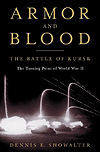
Armor and Blood: The Battle of Kursk, by Dennis E. Showalter, Random House, New York, 2013, $28
With all of the ink spilled by historians about the 1943 Battle of Kursk, one wonders whether there is room for yet another treatment of the subject. But in Armor and Blood accomplished military historian Dennis Showalter has produced a superb account of this enormous bloodletting on the Eastern Front. The book is a melding of the best research conducted and published to date, including new material made available by the opening of the Soviet archives in the post–Cold War period. Showalter handles this profusion of sources with a deft pen, combining the best of the newest theories of military history with an outstanding narrative account that will satisfy even the most ardent consumer of Waffen SS and Russian Guards battlefield tales.
Armor and Blood is much more than a guns and trumpets account of the largest armored encounter in the history of warfare. Showalter delves into the interwar history of the German and Soviet armies and discusses as well their various experiences in the early years of World War II that brought them to this epic watershed moment. He examines the motivations of the soldiers of the Red Army and the German landsers and armored crewmen who fought and died at the sharp end of brutal combat. Nothing escapes Showalter’s gaze: the strategic calculations of Hitler and his generals; the leadership of Stalin and his coterie of Red Army commanders; new technology such as the Tiger and Panther tanks that made their debut en masse at Kursk; the opposing air and artillery forces; the feats of logistics and engineering that turned the Kursk salient into the most formidable fortress in the world; and, of course, the operational and tactical maneuverings of forces that grappled to the death in a battle that definitively and irrevocably shifted the momentum on the Eastern Front to the Red Army in the summer of 1943. Before Kursk the war in the East was in the balance; afterward, there was little doubt it would end with Soviet armies in Berlin.
Armor and Blood is an engaging read with enough academic substance to attract the attention of accomplished military historians and sufficient color to engage the general reader. This book should be on the shelf of anyone interested in the history of armored warfare and/or the history of the massive Russo-German clash of arms during World War II.
—Peter R. Mansoor




